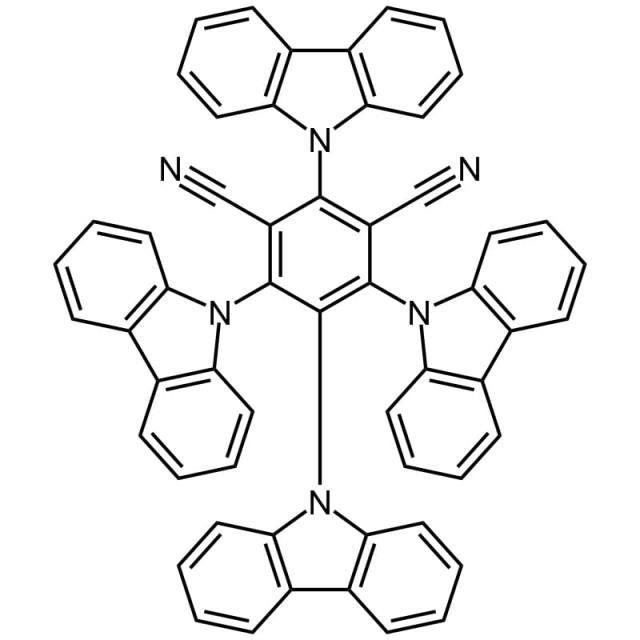The content on our website is provided solely for general informational purposes. It should not be considered, nor is it intended to provide advice or recommendations for the purchase, sale, or trade of any products or services. Importantly, the information presented does not constitute an offer to sell or a solicitation of an offer to buy any product.
Please be aware that the availability of our products may vary across different markets due to regulatory restrictions or other considerations. Consequently, not all products or services may be available in your region or country. For specific inquiries regarding the availability and pricing of any product, please contact us at sales@noctiluca.eu.
General information
-
Name:
4CzIPN
-
Full name:
1,2,3,5-Tetrakis(carbazol-9-yl)-4,6-dicyanobenzene
-
CAS number:
1416881-52-1
-
Chemical formula:
C56H32N6
-
Molecular weight:
788.89 g/mol
-
Absorption:
λmax = 365 nm in Acetonitrile
-
Photoluminescence:
λmax = 551 nm in Acetonitrile
-
HOMO/LUMO:
HOMO = 5.8 eV, LUMO = 3.4 eV
-
Synonyms:
2,4,5,6-Tetra(9H-carbazol-9-yl)isophthalonitrile
-
Classification:
Organic light-emitting diodes, Emmiting layer materials (EML), TADF materials, Green fluorescent dopant materials, PHOLED materials
-
Purity:
Sublimed: >99.0% (HPLC)
-
Melting point:
TGA: 366 - 368 °C
-
Appearance:
Orange to yellow powder/crystals
4CzIPN: The Apex of Green TADF Emitters in Organic Electronics
The ever-expanding domain of organic light-emitting diodes (OLEDs) is propelled by a diverse array of materials and compounds. Among them, 4CzIPN fully known as 1,2,3,5-Tetrakis(carbazol-9-yl)-4,6-dicyanobenzene stands as a pivotal element in the technology stack of organic devices.
Understanding 4CzIPN
4CzIPN is an organic compound distinguished by its donor-acceptor structure. The acceptor units in this molecule are two cyano groups at meta-positions, while the donor units are four carbazol molecules substituted in the remaining positions. This unique configuration makes it a popular green TADF emitter.
Key Features of 4CzIPN
- High Photoluminescence Quantum Efficiency (PLQY): 4CzIPN is characterized by its high photoluminescence quantum efficiency, making it an optimal choice for applications requiring high-efficiency light emission.
- Short Excited-State Lifetime: The compound exhibits a short excited-state lifetime of delayed fluorescence, contributing to its high external quantum efficiency (EQE) in TADF-OLED devices.
- Poor Solubility in Organic Solvents: One of the limitations of 4CzIPN is its poor solubility in most organic solvents, attributed to steric effects caused by closely located substituents. But it is soluble in dichloromethane and chloroform, which makes 4CzIPN a solution-processable compound.
- Applications in PHOLED Materials: 4CzIPN is also used as a host material in phosphorescent organic light-emitting diodes (PhOLEDs), further attesting to its versatility.
The Role of 4CzIPN in Modern OLEDs
In the current landscape of organic electronics, the demand for materials that offer high efficiency, durability, and low energy consumption is incessant. 4CzIPN, with its donor-acceptor structure and high PLQY, aligns seamlessly with these prerequisites. Its role as a green TADF emitter and its application in PhOLEDs make it a material of choice for next-generation organic electronic devices.
Conclusion
The organic electronics sector is continuously evolving, driven by the quest for materials that are both efficient and durable. 4CzIPN, with its unique donor-acceptor structure and high PLQY, is well-positioned to play a significant role in shaping the future of this industry. As research continues and technology advances, 4CzIPN is expected to find an expanding array of applications, particularly in TADF-OLED devices and PhOLEDs.
